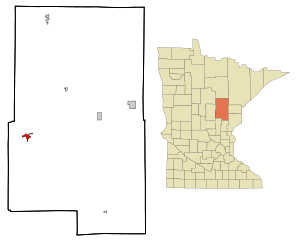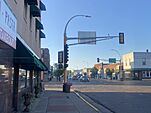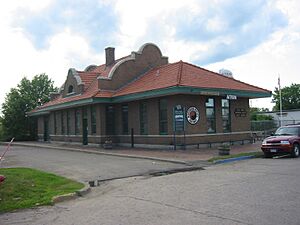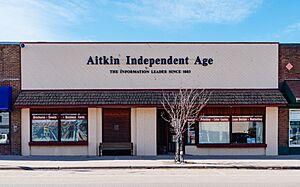Aitkin, Minnesota facts for kids
Quick facts for kids
Aitkin, Minnesota
|
|
|---|---|
|
Aitkin County Courthouse and Jail
Aitkin Carnegie Library
Businesses on Minnesota Avenue
|
|
| Motto(s):
"Historic Mississippi Riverboat Town"
|
|

Location of the city of Aitkin
within Aitkin County, Minnesota |
|
| Country | United States |
| State | Minnesota |
| County | Aitkin |
| Incorporated | August 19, 1889 |
| Area | |
| • Total | 2.93 sq mi (7.58 km2) |
| • Land | 2.92 sq mi (7.57 km2) |
| • Water | 0.01 sq mi (0.01 km2) |
| Elevation | 1,234 ft (376 m) |
| Population
(2020)
|
|
| • Total | 2,168 |
| • Density | 741.96/sq mi (286.49/km2) |
| Time zone | UTC-6 (Central (CST)) |
| • Summer (DST) | UTC-5 (CDT) |
| ZIP code |
56431
|
| Area code(s) | 218 |
| FIPS code | 27-00460 |
| GNIS feature ID | 2393894 |
Aitkin (pronounced AY-kin) is a city in Minnesota, United States. It is the main town, or county seat, of Aitkin County. In 2020, about 2,168 people lived there.
Contents
History of Aitkin
Before Aitkin became a city, there was a small community called Lexington. It was located where the Ripple River meets the Mississippi River. Maps from the 1860s sometimes showed a village called Ojibway in this area by mistake.
How Aitkin Started
Lexington was an important place for trade. Because of this, the Northern Pacific Railroad planned its tracks to go nearby. Aitkin was officially started in 1870 when the railroad reached this spot. It took over and replaced Lexington. The city and county were named after William Alexander Aitken. He was an important person in the fur trade business in the early 1800s.
Growth and Industries
Many people moved to Aitkin because of new jobs. In the late 1800s and early 1900s, lots of immigrants came. They were mostly from places like Ireland, Germany, and Scandinavian countries. They came to work in the logging (cutting down trees) and riverboat industries. Many of them started working even before they learned much English.
After the Great Depression and World War II, the logging industry became less important. The area then focused on farming. People raised cattle and poultry (like turkeys). This continued until the late 1970s and early 1980s. A creamery (for dairy products) and a turkey processing plant were very important to the town's money. Today, you can see many empty farms because small family farms are not as common anymore.
A Modern Town
By the 1990s, Aitkin changed again. It became a popular place for people to retire and for tourists to visit. This is especially true because of its many lakes. Today, tourism and service jobs are very important. Health care, education, and non-profit groups also help the economy.
Flooding in Aitkin
Aitkin has sometimes had floods from the Mississippi River. Big floods happened in 1950 and 2012. The 2012 flood was different because it was caused by heavy rain, not melting snow. This meant it flooded cabins near the lakes. In 2023, downtown Aitkin flooded again because of a lot of melting snow from winter.
Historic Buildings
Five buildings in Aitkin are listed on the National Register of Historic Places. This means they are important historical sites. They include:
- The 1901 Patrick Casey House
- The 1902 Potter/Casey Company Building
- The 1911 Aitkin Carnegie Library
- The 1916 Northern Pacific Depot
- The Aitkin County Courthouse and Jail (built in 1920 and 1915)
Geography and Climate
Aitkin covers about 2.20 square miles (5.70 square kilometers) of land.
Rivers and Creeks
The Mississippi River flows along the northern edge of Aitkin. The Ripple River and Sissabagamah Creek also flow nearby.
Weather in Aitkin
Aitkin has a climate with warm summers and cold winters.
| Climate data for Aitkin, Minnesota (1991–2020 normals, extremes 1958–present) | |||||||||||||
|---|---|---|---|---|---|---|---|---|---|---|---|---|---|
| Month | Jan | Feb | Mar | Apr | May | Jun | Jul | Aug | Sep | Oct | Nov | Dec | Year |
| Record high °F (°C) | 54 (12) |
57 (14) |
77 (25) |
90 (32) |
93 (34) |
97 (36) |
98 (37) |
100 (38) |
98 (37) |
86 (30) |
75 (24) |
60 (16) |
100 (38) |
| Mean daily maximum °F (°C) | 18.8 (−7.3) |
24.6 (−4.1) |
36.8 (2.7) |
51.5 (10.8) |
65.3 (18.5) |
74.7 (23.7) |
79.1 (26.2) |
76.9 (24.9) |
68.6 (20.3) |
54.7 (12.6) |
37.7 (3.2) |
24.5 (−4.2) |
51.1 (10.6) |
| Daily mean °F (°C) | 9.5 (−12.5) |
14.1 (−9.9) |
26.1 (−3.3) |
40.4 (4.7) |
52.7 (11.5) |
62.9 (17.2) |
67.6 (19.8) |
65.3 (18.5) |
57.1 (13.9) |
44.3 (6.8) |
29.8 (−1.2) |
17.1 (−8.3) |
40.6 (4.8) |
| Mean daily minimum °F (°C) | 0.1 (−17.7) |
3.6 (−15.8) |
15.4 (−9.2) |
29.3 (−1.5) |
40.0 (4.4) |
51.1 (10.6) |
56.1 (13.4) |
53.6 (12.0) |
45.6 (7.6) |
33.8 (1.0) |
21.9 (−5.6) |
9.6 (−12.4) |
30.0 (−1.1) |
| Record low °F (°C) | −47 (−44) |
−43 (−42) |
−37 (−38) |
−1 (−18) |
18 (−8) |
27 (−3) |
37 (3) |
33 (1) |
19 (−7) |
9 (−13) |
−22 (−30) |
−42 (−41) |
−47 (−44) |
| Average precipitation inches (mm) | 1.09 (28) |
0.98 (25) |
1.69 (43) |
2.82 (72) |
3.84 (98) |
4.44 (113) |
4.74 (120) |
3.29 (84) |
3.10 (79) |
2.93 (74) |
1.73 (44) |
1.25 (32) |
31.90 (810) |
| Average precipitation days (≥ 0.01 in) | 5.3 | 5.2 | 6.2 | 8.1 | 9.8 | 10.5 | 9.8 | 9.2 | 8.8 | 8.7 | 6.2 | 5.6 | 93.4 |
| Source: NOAA | |||||||||||||
People of Aitkin
| Historical population | |||
|---|---|---|---|
| Census | Pop. | %± | |
| 1880 | 136 | — | |
| 1890 | 737 | 441.9% | |
| 1900 | 1,719 | 133.2% | |
| 1910 | 1,638 | −4.7% | |
| 1920 | 1,490 | −9.0% | |
| 1930 | 1,545 | 3.7% | |
| 1940 | 2,063 | 33.5% | |
| 1950 | 2,079 | 0.8% | |
| 1960 | 1,829 | −12.0% | |
| 1970 | 1,553 | −15.1% | |
| 1980 | 1,770 | 14.0% | |
| 1990 | 1,698 | −4.1% | |
| 2000 | 1,984 | 16.8% | |
| 2010 | 2,165 | 9.1% | |
| 2020 | 2,168 | 0.1% | |
| U.S. Decennial Census 2020 Census |
|||
In 2010, there were 2,165 people living in Aitkin. There were 936 households, which are groups of people living together. About 483 of these were families.
Who Lives in Aitkin?
Most people in Aitkin are White (95.5%). There are also smaller groups of African American, Native American, and Asian people. Some people are from two or more races. About 1.2% of the population is Hispanic or Latino.
About 27.2% of households had children under 18. Many households (43.5%) were made up of single individuals. About 25.1% of households had someone aged 65 or older living alone. The average age in the city was 44.3 years old.
Fun Things to Do
Aitkin has several yearly festivals and events:
- Riverboat Heritage Days: This festival happens on the first weekend in August.
- The Aitkin County Fair: This fair takes place every year in the middle of July.
- Ripplesippi Music Fest: Enjoy music in mid-August.
- Harvest Moon Brew Fest: This event is held in September.
- World Famous Fish House Parade: This unique parade happens on Black Friday, the day after Thanksgiving. It was even featured in a TV show in 2003!
Education in Aitkin
Aitkin Public Schools serve the students in the area.
- Aitkin High School teaches students from seventh to twelfth grade.
- Rippleside Elementary teaches students from preschool to sixth grade.
Getting Around
Transportation
The Aitkin Municipal Airport is located on the northeast side of the city.
Major Roads
Several important roads pass through Aitkin:
 U.S. Highway 169
U.S. Highway 169 Minnesota State Highway 47
Minnesota State Highway 47 Minnesota State Highway 210
Minnesota State Highway 210 Aitkin County Road 1
Aitkin County Road 1 Aitkin County Road 12
Aitkin County Road 12- Aitkin County Road 15
- Aitkin County Road 41
- Aitkin County Road 54
Local News
The Aitkin Independent Age is a weekly newspaper in Aitkin. It has been around since 1883.
Famous People from Aitkin
Some notable people have connections to Aitkin:
- Franklin E. Ebner: A Minnesota politician and lawyer.
- Jonathan Edwards: A singer and songwriter, famous for his song "Sunshine."
- Leif Enger: An American author.
- Francis Lee Jaques: A well-known American wildlife painter.
- Jean Keene: Known as the "Eagle Lady" for her work with eagles.
- Robert Kerlan: An orthopedic surgeon who helped develop sports medicine.
- Gordon W. McKay: An Oregon businessman and politician.
- Marlin B. Nelsen: A Minnesota chiropractor and politician.
- David E. Rued: A Minnesota politician, farmer, and teacher.
- Warren William: A famous Broadway and film actor with a star on the Hollywood Walk of Fame.
- Edwin M. Wold: A Minnesota politician and businessman.
See Also
 In Spanish: Aitkin (Minnesota) para niños
In Spanish: Aitkin (Minnesota) para niños









